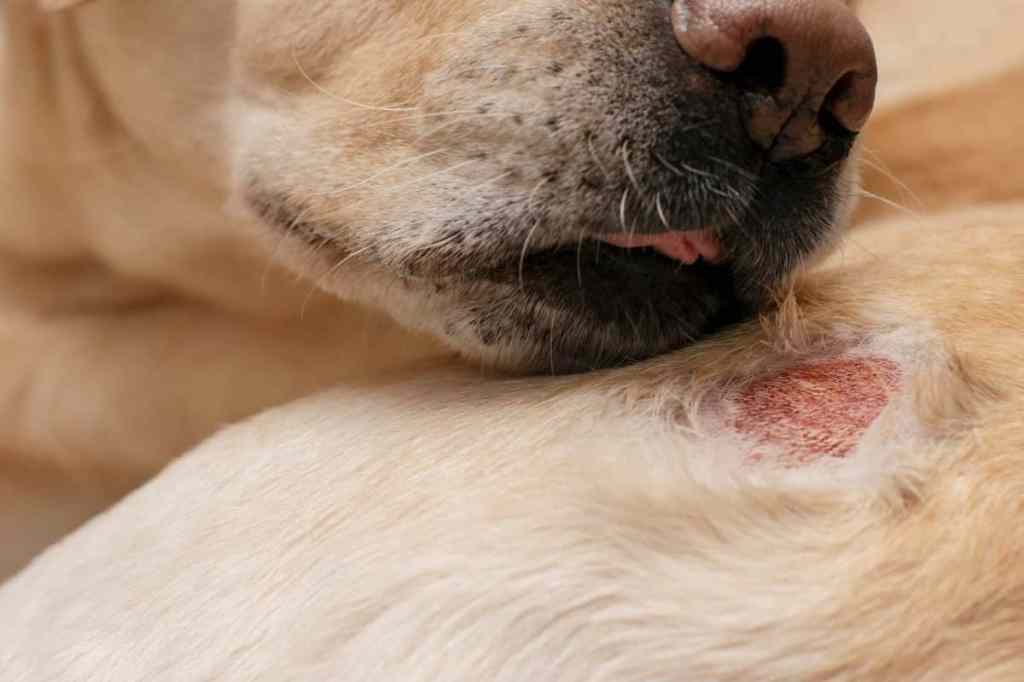Mange is a common and highly contagious skin disease in dogs, caused by various species of parasitic mites. These mites burrow into the dog’s skin, resulting in intense itching, inflammation, and hair loss. The condition can affect dogs of any age or breeds but is especially prevalent in puppies, senior dogs, and those with weakened immune systems. Mange spreads easily in environments where dogs are in close contact, such as kennels, shelters, and dog parks.
Here’s what you should know about the types, symptoms, causes, and treatments for the condition in dogs.
Types of mange in dogs

There are several types of mange in dogs, each caused by different species of mites and exhibiting distinct clinical signs. The most common types include:
Sarcoptic mange
Sarcoptic mange — commonly known as canine scabies — is caused by the Sarcoptes scabiei mite. The mites burrow into the skin and create tunnels where they lay their eggs. This burrowing activity results in severe itching and discomfort for the affected dog. Symptoms of sarcoptic mange often appear within 10 days to eight weeks after exposure. The condition typically begins in areas with less hair — such as the ears, elbows, abdomen, and chest — but it can spread to the entire body if left untreated.
This type of mange is highly contagious and can spread rapidly between dogs through direct contact or indirectly via bedding, grooming tools, and other contaminated surfaces. In fact, humans can also contract a mild form of sarcoptic mange from infected dogs. However, the mites cannot complete their life cycle on human skin, and the condition is usually self-limiting.
Demodectic mange
Demodectic mange — also referred to as demodicosis or red mange — is caused by the Demodex canis mite. In some cases, it may also involve Demodex injai or Demodex cornei mites. These mites are naturally found in small numbers on the skin of healthy dogs, where they inhabit hair follicles and sebaceous glands. Normally, a dog’s immune system effectively regulates the mite population. However, when the immune system is compromised or underdeveloped, these mites can multiply excessively, resulting demodectic mange.
Demodectic mange can manifest in two forms: localized and generalized.
- Localized demodicosis: This form of demodectic mange is commonly observed in puppies and young dogs. It appears as small, isolated patches of hair loss, usually on the face, legs, and trunk. In many cases, the condition resolves on its own as the dog’s immune system matures, often without requiring any treatment.
- Generalized demodicosis: This more severe form can affect dogs of any age and is characterized by widespread skin lesions, significant hair loss, and secondary bacterial infections. Generalized demodicosis may be a sign of an underlying immune deficiency or other health problems.
Unlike sarcoptic mange, demodectic mange is not contagious to other dogs or humans. Puppies usually acquire Demodex mites from their mothers during the first few days of life through close contact. Adult dogs with a healthy immune system generally do not develop demodectic mange, even if they are exposed to the mites.
Cheyletiellosis
Cheyletiellosis, or walking dandruff, is caused by Cheyletiella mites. These mites are relatively large and can be seen moving on the surface of the dog’s skin, giving the appearance of moving flakes of dandruff. This type of mange is mildly contagious and can affect other pets and even humans, although it tends to be more irritating than serious. Dogs with cheyletiellosis often exhibit excessive scratching and grooming due to the discomfort caused by the mites.
Otodectic mange
Also known as ear mite infestation, otodectic mange is caused by Otodectes cynotis mites. These mites predominantly infest the ear canals but can also spread to other parts of the body. Affected dogs may show symptoms such as ear scratching, head shaking, and dark, crusty ear discharge. In severe cases, ear mites can lead to secondary bacterial or yeast infections, which may result in more serious ear problems. Otodectic mange is highly contagious and can easily spread between pets through direct contact.
Symptoms of mange in dogs

One of the first signs of mange in dogs is persistent itching. Affected dogs often scratch, bite, or chew at their skin, sometimes to the point of causing bleeding or secondary infections. In addition to itching, other common symptoms include:
- Red, inflamed skin
- Hair loss, particularly in patches
- Scaly or crusty skin
- Thickening of the skin over time
- Presence of sores and lesions
- Foul odor from the skin due to secondary infections
- Behavioral changes, e.g. restlessness or irritability
If you notice any of these symptoms in your dog, take them to the vet as soon as possible for a proper diagnosis. Diagnosing mange generally involves a physical examination along with diagnostic tests. Your veterinarian may take skin scrapings to examine under a microscope, looking for the presence of mites or their eggs. In some cases, a skin biopsy may be necessary to confirm the diagnosis, especially if the infestation is severe or if the initial tests are inconclusive. Identifying the specific type of mite is crucial for determining the appropriate treatment plan, as different mites require different management approaches.
Causes of mange in dogs

Dogs contract mange primarily through the infestation of microscopic mites that reside on or within the skin. The two most common ways dogs become exposed to these mites are through close physical contact with an infested animal or by coming into contact with bedding, toys, or objects where the mites are present. Unsanitary living conditions — such as overcrowded shelters or poorly maintained kennels — can accelerate the spread of mange, as dogs are kept in close proximity. Once the mites find a host, they burrow into the skin, causing irritation, inflammation, and hair loss.
Mites thrive in warm, moist environments and can rapidly reproduce on the host, aggravating the skin issues further. The presence of these mites on a dog’s skin triggers an immune response, leading to the symptoms commonly associated with mange, such as itching, redness, and scaly skin. Dogs with weakened immune systems are particularly vulnerable to mange. This is because factors like age, illness, malnutrition, or stress can compromise a dog’s immune defenses, making it easier for mites to establish an infestation.
Treatments for mange in dogs

If your pup is diagnosed with mange, it’s vital to act quickly to ease their discomfort and prevent the condition from worsening. Based on the type of mange and the severity of their condition, the veterinarian will suggest one or more of the following treatment options:
- Medicated baths and dips: Your vet might recommend medicated shampoos or dips to kill mites and soothe your dog’s skin. These products often contain ingredients like lime sulfur, amitraz, or benzoyl peroxide. Follow your vet’s instructions carefully when using these treatments to ensure effectiveness and safety.
- Oral medications: In addition to medicated baths, your vet may also prescribe oral medications. These drugs work systemically to kill the mites and often provide quicker relief. Medications like ivermectin, milbemycin, or afoxolaner can be effective, but it’s important to use them under veterinary guidance due to potential side effects.
- Topical treatments: In some cases, topical treatments can be applied directly to your dog’s skin to eliminate mites. These treatments might include moxidectin or selamectin, which are usually applied on a monthly basis.
- Antibiotics and antifungals: If your dog has developed secondary infections due to skin irritation and scratching, antibiotics or antifungal medications may be necessary. Your vet will prescribe these if they detect any signs of infection.
- Regular grooming: Regular grooming can help remove dead skin, soothe irritation, and monitor your dog’s progress. Use a gentle brush and avoid any products that could further irritate your dog’s skin.
Can dogs survive mange?
Mange is a treatable condition, and with proper care, most dogs can make a full recovery. If your dog has sarcoptic mange, the outlook is generally favorable with timely treatment. Despite being highly contagious, this type of mange typically responds well to treatment. As such, you can expect to see noticeable improvement within a few weeks, with full recovery likely within one to two months.
On the other hand, demodectic mange tends to affect dogs with weakened immune systems, making treatment more challenging. This is because effective treatment often requires addressing underlying immune deficiencies, which can be complex and prolonged. What’s more, recovery times for demodectic mange can vary; localized cases may clear up on their own or with minimal intervention within a few weeks. However, generalized cases might require more intensive, long-term treatment, sometimes taking several months before significant improvement is seen.
In any case, though, early diagnosis and following your vet’s treatment plan are crucial for ensuring your pet recovers as quickly and comfortably as possible.
Prevention of mange in dogs

Once your dog has recovered from mange, it’s important to take steps to prevent future outbreaks. Here are a few things you can do:
- Practice good hygiene: Mange mites can survive in your dog’s environment, so it’s essential to clean their living area thoroughly. Wash their bedding, toys, and any other items they frequently come into contact with. Vacuum your home regularly and consider using mite-killing sprays — after first verifying the product is pet-safe — for a more comprehensive approach.
- Improve your dog’s immune system: A strong immune system can help your dog fight off infections and recover more quickly. Ensure your dog is on a nutritious diet, gets regular exercise, and is up-to-date on vaccinations. You may also consider supplements, but consult your vet before introducing anything new.
- Use preventive treatments: Discuss preventative treatments with your veterinarian. They might recommend topical treatments or specific shampoos to protect your dog from mange. Since parasites can contribute to the development of mange, it is important to keep them at bay.
- Limit exposure to infected animals: Mange is contagious, so avoid letting your dog come into contact with animals who show signs of mange. If you notice symptoms in other pets or local animals, keep your dog away and inform your vet.
Remember, your veterinarian is your most trusted source for personalized guidance on your dog’s health. Avoid self-diagnosing or attempting to treat your pet at home without first consulting a professional. Mange can mimic other skin diseases, and administering the wrong treatment may inadvertently worsen your dog’s condition. Always seek the expertise of a vet to ensure the best possible outcome for your furry friend.









